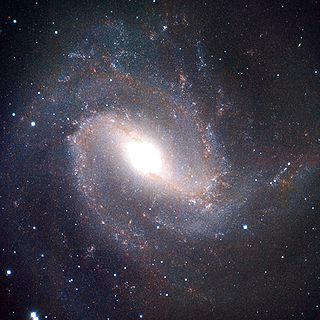Messier Index/M83
| Messier 83 | |
|---|---|
 An w:ESO image of Messier 83. Credit: ESO. | |
| Observation data (w:J2000 epoch) | |
| Constellation | Hydra |
| Right ascension | 13h 37m 00.9s[1] |
| Declination | -29° 51′ 57″[1] |
| Redshift | 513 ± 2 km/s[1] |
| Distance | 14.7 Mly (4.5 Mpc)[2] |
| Type | SAB(s)c[1] |
| Apparent dimensions (V) | 12′.9 × 11′.5[1] |
| Apparent magnitude (V) | 8.2[1] |
| Other designations | |
| NGC 5236,[1] UGCA 366,[1] PGC48082,[1] Southern Pinwheel Galaxy,[3] | |
Messier 83 (also known as the Southern Pinwheel Galaxy, M83 or NGC 5236) is an w:intermediate spiral galaxy approximately 15 million w:light-years away in the w:constellation Hydra. It is one of the closest and brightest barred spiral galaxies in the sky, making it visible with w:binoculars. Six w:Supernovae (w:SN 1923A, w:SN 1945B, w:SN 1950B, w:SN 1957D, w:SN 1968L and w:SN 1983N) have been observed in M83.
History
Pierre Mechain discovered M83 in 1752 at the w:Cape of Good Hope.[4] w:Charles Messier added it to his catalogue of nebulous objects (now known as the w:Messier Catalogue) in March 1781.[4]
On w:16 June w:2008 NASA's w:Galaxy Evolution Explorer project reported finding large numbers of new stars in the outer reaches of the galaxy. It had hitherto been thought that these areas lacked the materials necessary for star formation. [1]
Nearby galaxies and galaxy group information
M83 is at the center of one of two subgroups within the w:Centaurus A/M83 Group, a nearby w:group of galaxies.[2] w:Centaurus A is at the center of the other subgroup. These two groups are sometimes identified as one group[5][6] and sometimes identified as two groups.[7] However, the galaxies around Centaurus A and the galaxies around M83 are physically close to each other, and both subgroups appear not to be moving relative to each other.[8]
External links
- M83, SEDS Messier pages
- Spiral Galaxy Messier 83 at the astro-photography site of Mr. Takayuki Yoshida.
- M83 The Southern Pinwheel
References
- ↑ a b c d e f g h i "NASA/IPAC Extragalactic Database". Results for NGC 5236. Retrieved 2006-12-08.
- ↑ a b I. D. Karachentsev, M. E. Sharina, A. E. Dolphin, E. K. Grebel, D. Geisler, P. Guhathakurta, P. W. Hodge, V. E. Karachetseva, A. Sarajedini, P. Seitzer (2002). "New distances to galaxies in the Centaurus A group". Astronomy and Astrophysics. 385: 21–31. doi:10.1051/0004-6361:20020042.
{{cite journal}}: CS1 maint: multiple names: authors list (link) - ↑ "SIMBAD astronomical database". Results for M83. Retrieved 2007-05-02.
- ↑ a b K. G. Jones (1991). Messier's Nebulae and Star Clusters (2nd ed.). Cambridge: Cambridge University Press. ISBN 0-521-37079-5.
- ↑ R. B. Tully (1988). Nearby Galaxies Catalog. Cambridge: Cambridge University Press. ISBN 0-521-35299-1.
- ↑ P. Fouque, E. Gourgoulhon, P. Chamaraux, G. Paturel (1992). "Groups of galaxies within 80 Mpc. II - The catalogue of groups and group members". Astronomy and Astrophysics Supplement. 93: 211–233.
{{cite journal}}: CS1 maint: multiple names: authors list (link) - ↑ A. Garcia (1993). "General study of group membership. II - Determination of nearby groups". Astronomy and Astrophysics Supplement. 100: 47–90.
- ↑ I. D. Karachentsev (2005). "The Local Group and Other Neighboring Galaxy Groups". Astronomical Journal. 129: 178–188. doi:10.1086/426368.